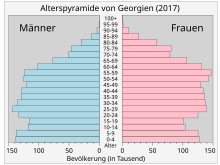Demography of Georgia
This article covers the demographics of Georgia . According to the statistical office of Georgia , there were 4,497,600 people in Georgia (excluding Abkhazia and South Ossetia ) in 2012.
After the self-dissolution of the Soviet Union, the Georgian population shrank significantly. Many minorities, including around 300,000 Russians , 40,000 Ukrainians , 25,000 Georgian Jews , 80,000 Greeks and 200,000 Armenians , left the country and went to their old homeland or emigrated. Since Georgia's declaration of independence and the wars in Abkhazia and South Ossetia, many ethnic Georgians have gone abroad because of the difficult financial and social situation. From 1989 to 2004, Georgia lost nearly one million people.
Population by age group and gender
| Age group (in years) |
Population (in 1000) |
Share in the population |
|---|---|---|
| <10 | 0.518 | 11.5 |
| 10-19 | 0.547 | 12.2 |
| 20-29 | 0.731 | 16.2 |
| 30-39 | 0.644 | 14.3 |
| 40-49 | 0.620 | 13.8 |
| 50-59 | 0.596 | 13.3 |
| 60-69 | 0.350 | 7.8 |
| 70-79 | 0.339 | 7.5 |
| 80-85 | 0.093 | 2.1 |
| > 85 | 0.060 | 1.3 |
| total | 4.497 | 100.0 |
The 20 to under 34 year olds were the largest age group in Georgia in 2012 . Their share in the total population was 24.3%. The under 35-year-olds together made up 47.5% of the total population. Twenty years ago this proportion was significantly higher, namely 56.2%.
Of approximately 4.5 million people, 2,143,800 were male (47.66%) and 2,353,872 were female (52.44%). The proportion of women was highest in the age groups of 20 to 24 year olds. The figures are the same for men. The proportion of men was lowest in the age groups between 75 and 85 years of age. It was 4.7% of the total population.
Birth rate
In 2011, 58,014 children were born alive. The number of deaths was 49,818. This results in a birth surplus of 8,196. In 2010 the birth surplus was still 14,721 and shortly after the break of the Soviet Union this number was around 40,000. This means that the birth surplus has decreased by almost 60% over the past 20 years. With only 1,390 people, the birth surplus was lowest in 2000, and since then more children have been born in Georgia than there are deaths.
In 1990 there were 92,815 births in Georgia, in 2000 only 48,800 children were born, in 2011 this number was 58,014, which corresponds to an increase of 9,214 children. Of the 58,014 children, 57.7% were born in cities and 42.3% in rural areas.
20 to 24 year olds have the most children in Georgia. This age group gave birth to 20,343 children in 2011. In second place was the age group of 25 to 29 year olds, followed by 30 to 34 year olds. Women older than 35 and younger than 44 have the fewest children, even fewer than those who are younger than 20 years old.
Population of Georgia by region
Tbilisi is the most populous region in Georgia. In 2012, 1.172 million people lived in the country's capital, 26% of the total Georgian population. 20 years ago there were still 1,259,692 people living in Tbilisi.
Imereti is the second most populous region in the country, with 707,500 people (15.7% of the total population). In third place is Kvemo Kartli with over 500,000 inhabitants, followed by Samegrelo-Zemo Svaneti (479,512), Kakheti (407,100), Adjara (393,700).
The most populous Georgian regions include Ratscha-Letschchumi and Lower Vanetia (47,000), Mtskheta-Mtianeti (109,000) and Guria (140,300).
Most of the children born in Georgia were born in Tbilisi (28.8%), followed by Imereti (15.23%), Lower Cartlia (12.1%), Adjara (9.8%), Mingrelia-Upper Svaneti (8.7 %), Kakheti (8.1%), Inner Kartlien (7.2%).
There are regional differences in the birth surplus, while in Tbilisi (+4,424), Niederkartlien (+2,693), Adjara (+2,429) and Inner Kartlien (+520) more children were born than there were deaths, while in other Georgian regions there was a birth deficit (in Kakheti -661; Ratscha-Letschchumi and Lower Vanetia -415; Mingrelia-Upper Vanetia -413; Guria -290).
Cities in Georgia
The following table contains the seven largest cities in Georgia, the results of the census of January 12, 1989 and January 17, 2002 as well as a calculation for January 1, 2009. The population figures refer to the actual cities without suburbs.
| rank | transcription | Georgian | 1989 | 2002 | 2009 | Administrative unit |
|---|---|---|---|---|---|---|
| 1. | Tbilisi | თბილისი | 1,259,692 | 1,072,887 | 1,106,700 | |
| 2. | Kutaisi | ქუთაისი | 234,870 | 183,691 | 188,600 | Imereti |
| 3. | Batumi | ბათუმი | 136,609 | 121.221 | 122,500 | Adjara |
| 4th | Rustavi | რუსთავი | 158,661 | 114,331 | 117,400 | Niederkartlien |
| 5. | Zugdidi | ზუგდიდი | 50,022 | 68,558 | 72,300 | Mingrelia and Upper Svaneti |
| 6th | Gori | გორი | 68,924 | 49,137 | 50,800 | Inner Cartlia |
| 7th | Potentiometer | ფოთი | 50,922 | 46.161 | 47,500 | Mingrelia and Upper Svaneti |
Web links
Individual evidence
- ↑ NATIONAL STATISTICS OFFICE OF GEORGIA. (PDF) Retrieved March 24, 2013 (Georgian / English, p. 11).
- ↑ Urban population of the Union Republics (except RSFSR) on the website of Demoscope Weekly / Institute for Demography of the State University / Moscow School of Economics (Russian)
- ↑ Sakartwelos mossachleobis 2002 zlis pirweli erownuli saqoweltao aghzeris schedegebi . tape 4 . Sakartwelos Statistics Sachelmzipo Departamenti, Tbilissi 2004, ISBN 99928-0-924-8 , p. 7–23 (2002 census results; Georgian).
- ↑ Statistical Yearbook Of Georgia, 2009 of the National Bureau of Statistics of Georgia (English, Georgian; excluding cities in Abkhazia and South Ossetia)
